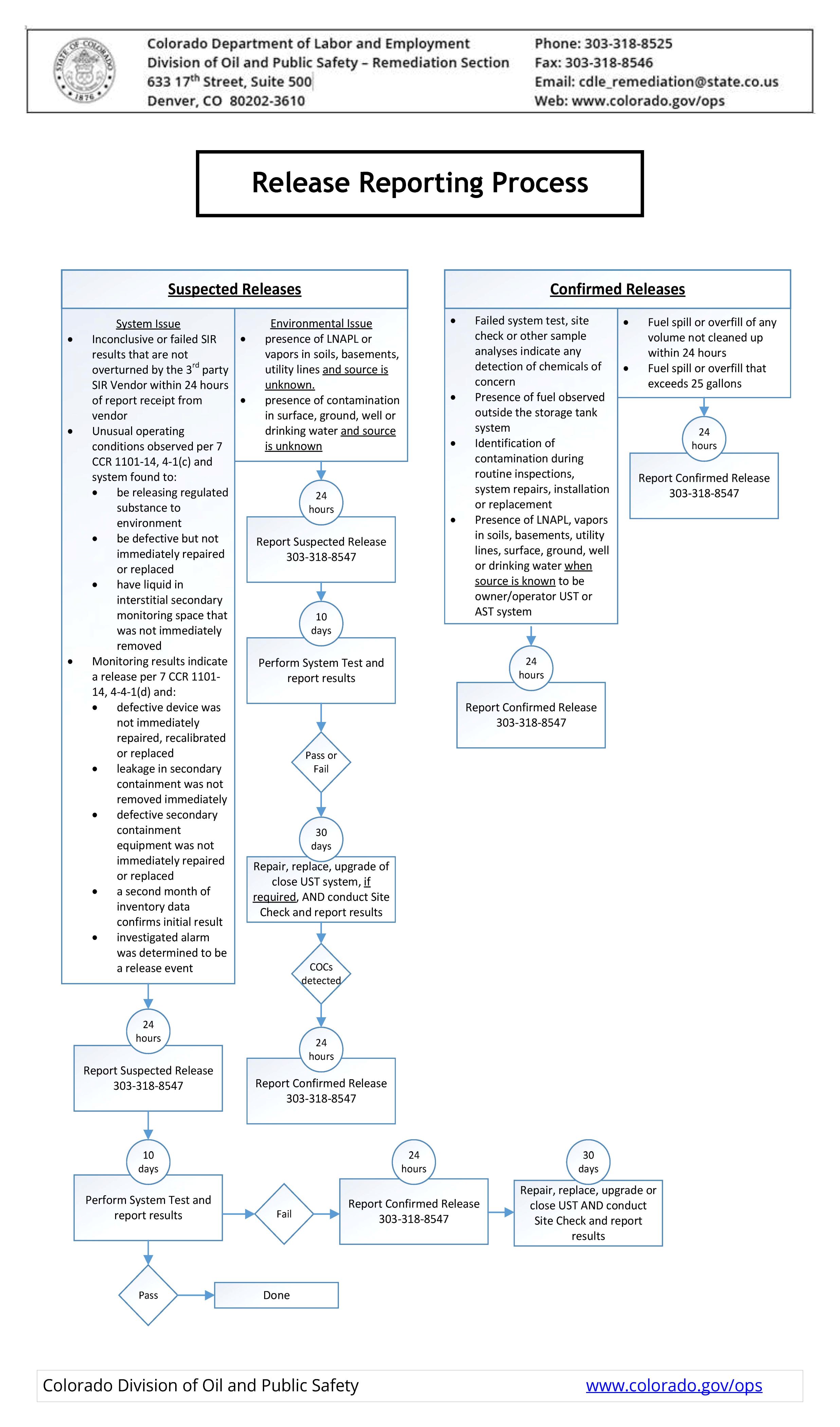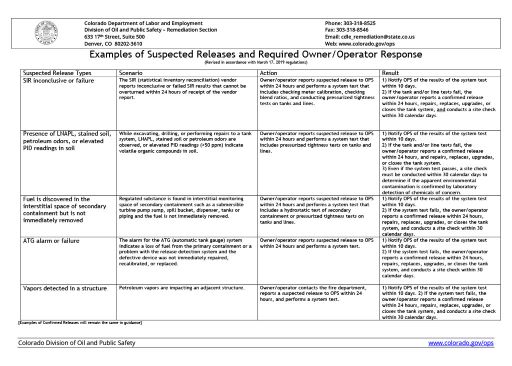Release Discovery and Reporting
Owners/operators of petroleum storage tank systems are responsible to identify, report and investigate Suspected and Confirmed releases from their system.
- Suspected releases are based on indirect evidence of a regulated substance outside the tank system, and will require a tank System Test and Site Check .
- Confirmed releases are identified by direct evidence of a regulated substance outside of the tank system.
This information below provides examples of suspected and confirmed conditions that require immediate action with suggested actions to respond to those conditions. Release discovery and reporting is critical to protect public health, minimize environmental damage and reduce related cleanup efforts.
Actions Necessary Within 24 Hours of Release Discovery
Take immediate action when a release is discovered to reduce the risk to human health and the environment, including the steps below.
- Stop the release.
- Visually inspect the area.
- Prevent fuel from spreading into storm drains or sewers where it may affect surface water (streams, lakes, etc.) or cause explosions.
- Eliminate or reduce fire, explosion or vapor hazards to the maximum extent possible and call 911.
- Within 24 hours, call the OPS Technical Assistance Line at (303) 318-8547 or file an online report using this form( Release Reporting Form) to report the release. (If the release occurs outside of normal business hours, leave a message.)
- The following information is helpful when reporting a release.
- Facility name, address, and facility ID number, if known
- Date the release was discovered
- What happened (Including product type, amount of product released, cause of the release, and response actions taken)
- Facility Owner’s and caller’s contact information
- If fuel enters a storm drain or surface water, also call the Colorado Department of Public Health and Environment release hotline at (877) 518-5608.
Did you know??
Did you know that you may be eligible to receive reimbursement from the State to help with cleanup? Report releases to OPS within 24 hours of discovery to avoid reducing the amount of your potential reimbursement.
Scenario: The alarm for the ATG (automatic tank gauge) system indicates a loss of product from your primary containment or a problem with the release detection system. The ATG system may need maintenance.
Action: Check to be sure the release detection is working properly and that there has not been a release. Contact your compliance contractor as soon as possible to see if a repair is needed. You must receive a passing result within 24 hours of the alarm.
Result: Notify OPS with the results of the investigation and repairs, if any. A site check must be completed within 30 calendar days of the release discovery if the results of the investigation suggest that a release has occurred.
Scenario: The SIR (statistical inventory reconciliation) vendor reports inconclusive SIR results that cannot be overturned within 24 hours, or the vendor reports failed SIR results for the previous month.
Action: Owner/operator notifies OPS of the failed SIR report and begins a system test that includes checking meter calibration, checking blend ratios and conducting pressurized tightness tests on tanks and lines.
Result: Notify OPS of the results of the System Test. If the tank and line tests fail, the owner/operator must perform a site check around the failing components of the system.
Scenario: Liquid was found in areas such as the submersible turbine pump sump or under-dispenser containment of a dispenser above the pipe entry.
Action: Contact your compliance contractor to have the product pumped out. The secondary containment should then be hydrostatically tested before and after repairs are completed.
Result: Contact OPS with the results of the hydrostatic test. If there is a failed result, a site check will be necessary.
Scenario: A regulated substance is found in contact with a damaged portion of the spill bucket or damage to the bottom of the spill bucket is observed.
Action: Remove all liquid from the spill bucket and conduct a hydrostatic or vacuum test. If the spill bucket shows evidence of cracks or any other signs of damage, complete the spill bucket assessment while replacing it.
Result: Notify OPS of the results of the system test. If the test fails, the owner/operator must perform a site check around the failing components of the system.
Scenario: During a routine piping test, a product line has failed.
Action: A site check must be conducted within 30 calendar days. Repairs need to be done to the line and a pressurized line tightness test must be performed.
Results: Submit the site check results and the repair documents showing the passing line tightness test to OPS.
Scenario: While excavating, drilling or performing repairs to the tank system, stained soil or petroleum odors are observed, or the photoionization detector indicates elevated levels (> 50 ppmv) of volatile organic compounds in soil.
Action: Contact OPS and perform a site check. See Chemicals of Concern for analytical requirements.
Result: Notify OPS of the results of the site check. If any detections are reported, you must report a confirmed release.
Scenario: Petroleum vapors are impacting an adjacent building.
Action: Contact the fire department and OPS. Work with the fire department to evacuate the structure, if necessary, and perform a tank system test.
Result: Notify OPS of the system test results.
Examples of CONFIRMED Releases
Scenario: Chemicals of concern are detected in soil or groundwater samples associated with a tank system.
Action: Report a confirmed released to OPS within 24 hours of receipt of the laboratory report.
Result: Begin assessment in anticipation of submitting the Site Characterization Report to OPS within 180 days of the release discovery.
Scenario 1: During the removal of a UST system, shallow groundwater is encountered and regulated substance is noted to be present on groundwater in the UST pit.
Scenario 2: Product is dripping from a pump or under a dispenser with no secondary containment.
Scenario 3: During a site assessment, regulated substance is discovered from a regulated tank system.
Action: Report a confirmed released to OPS within 24 hours of discovery. Mitigation of LNAPL (light non-aqueous phase liquid) must begin immediately. Remove LNAPL and define the aerial extent of the release.
Result: Begin assessment in anticipation of submitting the Site Characterization Report to OPS within 180 days of the release discovery.
Scenario: A customer is in the process of filling their vehicle tank and leaves the dispenser unattended to go inside the convenience store. The vehicle gas tank fills up, but the nozzle does not stop dispensing fuel. The fuel then flows onto the ground surface towards soil and a nearby sewer.
Action: Activate the emergency stop button and call 911 to report the release to the local fire department.
Apply absorbent material and spill booms to the spill area to prevent the fuel from impacting any soil or utilities (do not flush or rinse product down storm drains). Make the A/B operator (or primary contact) aware of the situation.
Contact an environmental cleanup contractor, your compliance contractor or an environmental consultant.
Result: Begin assessment in anticipation of submitting the Site Characterization Report to OPS within 180 days of the release discovery. Alternatively, OPS may request that the owner/operator complete a Surface Release Characterization Report if the release is under 100 gallons and no impacts to soil, groundwater or storm sewers were observed.
OPS recommends contracting with a Recognized Environmental Professional to aid in your release response and reporting.

